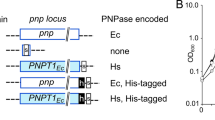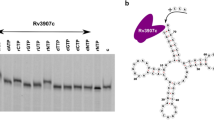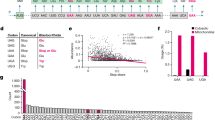Abstract
We have previously demonstrated that transcripts of an AT-biased heterologous gene encoding mite allergen Der f 7 from Dermatophagoides farinae were polyadenylated prematurely within the coding region when native cDNA was expressed in Aspergillus oryzae, and that this premature polyadenylation was prevented by the codon optimization of the Der f 7 gene, resulting in increased steady-state mRNA levels. In this study, we tested the stability of transcription products derived from expression constructs of the native and codon-optimized Der f 7 gene in A. oryzae using 1,10-phenanthroline as a transcription inhibitor. Transcription products of native Der f 7 cDNA fused to the A. oryzae glucoamylase gene (glaA) were rapidly degraded; the half-life of the mRNA was approximately 13 min. However, the half-life of codon-optimized Der f 7 mRNA fused to glaA was approximately 43 min, which was highly similar to that of endogenous glaA mRNA. These results indicate that Der f 7 mRNA is significantly stabilized by codon optimization. In addition, Der f 7 mRNA was stabilized by the codon optimization of only the 3′-half region, where premature polyadenylation sites were exclusively situated; the half-life of the chimeric Der f 7 mRNA was approximately 39 min. This suggested that destabilization of native Der f 7 mRNA is mainly triggered by premature polyadenylation within the coding region. To the best of our knowledge, this is the first report to provide experimental evidence that heterologous mRNA is significantly stabilized by codon optimization in eukaryotic cells.






Similar content being viewed by others
References
Atwar JA, Wisdom R, Verma IM (1990) Regulated mRNA stability. Ann Rev Genet 24:519–541
Caddick MX, Jones MG, van Tonder JM, Cordier HL, Narendja F, Strauss J, Morozov IY (2006) Opposing signals differentially regulate transcript stability in Aspergillus nidulans. Mol Microbiol 62:509–519
Christensen T, Woeldike H, Boel F, Mortensen SB, Hjortshoej K, Thim L, Hansen M (1988) High level expression of recombinant genes in Aspergillus oryzae. Bio/Technology 6:1419–1422
Doma MK, Parker R (2007) RNA quality control in eukaryotes. Cell 131:660–668
Fleissner A, Dersch P (2010) Expression and export: recombinant protein production systems for Aspergillus. Appl Microbiol Biotechnol 87:1255–1270
Frischmeyer PA, van Hoof A, O’Donnell K, Guerrerio AL, Parker R, Dietz HC (2002) An mRNA surveillance mechanism that eliminates transcripts lacking termination codon. Science 295:2258–2261
Furger A, O'Sullivan JM, Binnie A, Lee BA, Proudfoot NJ (2002) Promoter proximal splice sites enhance transcription. Genes Dev 16:2792–2799
Garneau NL, Wilusz J, Wilusz CJ (2007) The highways and byways of mRNA decay. Nat Rev Mol Cell Biol 8:113–126
Gomi K, Iimura Y, Hara S (1987) Integrative transformation of Aspergillus oryzae with a plasmid containing the Aspergillus nidulans argB gene. Agric Biol Chem 51:2549–2555
Gouka RJ, Punt PJ, Hessing JGM, van den Hondel CAMJJ (1996) Analysis of heterologous protein production in defined recombinant Aspergillus awamori strains. Appl Environ Microbiol 62:1951–1957
Gouka RJ, Punt PJ, van den Hondel CAMJJ (1997a) Efficient production of secreted proteins by Aspergillus: progress, limitations and prospects. Appl Microbiol Biotechnol 47:1–11
Gouka RJ, Punt PJ, van den Hondel CAMJJ (1997b) Glucoamylase gene fusions alleviate limitations for protein production in Aspergillus awamori at the transcriptional and (post)transcriptional levels. Appl Environ Microbiol 63:488–497
Grigull J, Mnaimneh S, Pootoolal J, Robinson MD, Hughes TR (2004) Genome-wide analysis of mRNA stability using transcription inhibitors and microarrays reveals posttranscriptional control of ribosome biogenesis factors. Mol Cell Biol 24:5534–5547
Guo J, Cheng P, Yuan H, Kiu Y (2009) The exosome regulates circadian gene expression in a posttranscriptional negative feedback loop. Cell 138:1236–1246
Inada T, Aiba H (2005) Translation of aberrant mRNAs lacking a termination codon or with a shortened 3′-UTR is repressed after initiation in yeast. EMBO J 24:1584–1595
Isken O, Maquat LE (2007) Quality control of eukaryotic mRNA: safeguarding cells from abnormal mRNA function. Genes Dev 21:1833–1856
Ito-Harashima S, Kuroha K, Tatematsu T, Inada T (2007) Translation of the poly(A) tail plays crucial roles in nonstop mRNA surveillance via translation repression and protein destabilization by proteasome in yeast. Genes Dev 21:519–524
Köhler A, Hurt E (2007) Exporting RNA from the nucleus to the cytoplasm. Nat Rev Mol Cell Biol 8:761–773
Le Hir H, Nott A, Moore MJ (2003) How introns influence and enhance eukaryotic gene expression. Trends Biochem Sci 28:215–220
Lubertozzi D, Keasling JD (2009) Developing Aspergillus as a host for heterologous expression. Biotechnol Adv 27:53–75
Machida M, Yamada O, Gomi K (2008) Genomics of Aspergillus oryzae: learning from the history of koji mold and exploration of its future. DNA Res 15:173–183
Mizutani O, Furukawa K, Ichiyanagi S, Matsuda Y, Tokuoka M, Fujioka T, Yamagata Y, Gomi K, Abe K (2009) Alternative processing of proproteins in Aspergilli kexB gene disruptants under hyperosmotic conditions. Biosci Biotechnol Biochem 73:40–46
Nott A, Meislin SH, Moore MJ (2003) A quantitative analysis of intron effects on mammalian gene expression. RNA 9:607–617
Ohno A, Maruyama J, Nemoto T, Arioka M, Kitamoto K (2011) A carrier fusion significantly induces unfolded protein response in heterologous protein production by Aspergillus oryzae. Appl Microbiol Biotechnol 92:1197–1206
Pakula TM, Laxell M, Huuskonen A, Uusitalo J, Saloheimo M, Penttilä M (2003) The effects of drugs inhibiting protein secretion in the filamentous fungus Trichoderma reesei. Evidence for down-regulation of genes that encode secreted proteins in the stressed cells. J Biol Chem 278:45011–45020
Passos DO, Parker R (2008) Analysis of cytoplasmic mRNA decay in Saccharomyces cerevisiae. Methods Enzymol 448:409–427
Platt A, Langdon T, Arst HN, Kirk D, Tollervey D, Sanchez JM, Caddick MX (1996) Nitrogen metabolite signaling involves the C-terminus and the GATA domain of the Aspergillus transcription factor AreA and the 3′ untranslated region of its mRNA. EMBO J 15:2791–2801
Sambrook J, Fritsch EF, Maniatis T (1989) Molecular cloning, a laboratory manual. Cold Spring Harbor Laboratory, Cold Spring Harbor
Tamalampudi S, Rahman MMT, Hama S, Suzuki Y, Kondo A, Fukuda H (2007) Development of recombinant Aspergillus oryzae whole-cell biocatalyst expressing lipase-encoding gene from Candida antarctica. Appl Microbiol Biotechnol 75:387–395
Tanaka M, Sakai Y, Yamada O, Shintani T, Gomi K (2011) In silico analysis of 3′-end-processing signals in Aspergillus oryzae using expressed sequence tags and genomic sequencing data. DNA Res 18:189–200
Tokuoka M, Tanaka M, Ono K, Takagi S, Shintani T, Gomi K (2008) Codon optimization increases steady-state mRNA levels in Aspergillus oryzae heterologous gene expression. Appl Environ Microbiol 74:6538–6546
Tsuchiya K, Tada S, Gomi K, Kitamoto K, Kumagai C, Jigami Y, Tamura G (1992) High level expression of the synthetic human lysozyme gene in Aspergillus oryzae. Appl Microbiol Biotechnol 38:109–114
Tsuchiya K, Gomi K, Kitamoto K, Kumagai C, Tamura G (1993) Secretion of calf chymosin from the filamentous fungus Aspergillus oryzae. Appl Microbiol Biotechnol 40:327–332
Tsuchiya K, Nagashima T, Yamamoto Y, Gomi K, Kitamoto K, Kumagai C, Tamura G (1994) High level secretion of calf chymosin using a glucoamylase-prochymosin fusion gene in Aspergillus oryzae. Biosci Biotechnol Biochem 58:895–899
van Hoof A, Frischmeyer PA, Dietz HC, Parker R (2002) Exosome-mediated recognition and degradation of mRNAs lacking a termination codon. Science 295:2262–2264
Yamada O, Lee BR, Gomi K (1997) Transformation system for Aspergillus oryzae with double auxotrophic mutations, niaD and sC. Biosci Biotechnol Biochem 61:1367–1369
Acknowledgments
We thank Natsumi Okada for the DNA sequencing. This work was supported in part by a Grant-in-Aid for Scientific Research on Priority Areas, Applied Genomics (no. 17019001), from the Ministry of Education, Culture, Sports, Science and Technology of Japan. M. Tanaka was the recipient of a JSPS Fellowship for Japanese Young Scientists.
Author information
Authors and Affiliations
Corresponding author
Electronic supplementary material
Below is the link to the electronic supplementary material.
ESM 1
3′-RACE analysis of Der f 7 cDNA using total RNA prepared from mycelia treated with 1,10-phenanthroline for 20 min. a Analysis of the inserted fragments of 3′-RACE clones. First-strand cDNA was synthesized from the total RNA that was used for Northern blot analysis in Fig. 2 (time 0). Amplified PCR fragments of Der f 7 cDNA were cloned into the pCRII TA-cloning vector, as described previously (Tokuoka et al. 2008). The resulting plasmid DNAs were digested with EcoRI, followed by agarose gel electrophoresis. The arrow indicates the bands of the TA-cloning vector used for cloning of the RT-PCR products, while the arrowhead indicates the molecular marker of 500 bp. b Polyadenylation sites of native Der f 7 mRNA determined by the sequencing of 3′-RACE clones. The nucleotide sequence of the coding region is indicated in uppercase letters, whereas the terminator sequence is indicated in lowercase letters. Arrows indicate the polyadenylation sites, while the numbers beside the arrows indicate the number of clones containing a poly(A) tract at the indicated position. (PDF 214 kb)
Rights and permissions
About this article
Cite this article
Tanaka, M., Tokuoka, M., Shintani, T. et al. Transcripts of a heterologous gene encoding mite allergen Der f 7 are stabilized by codon optimization in Aspergillus oryzae . Appl Microbiol Biotechnol 96, 1275–1282 (2012). https://doi.org/10.1007/s00253-012-4169-y
Received:
Revised:
Accepted:
Published:
Issue Date:
DOI: https://doi.org/10.1007/s00253-012-4169-y




